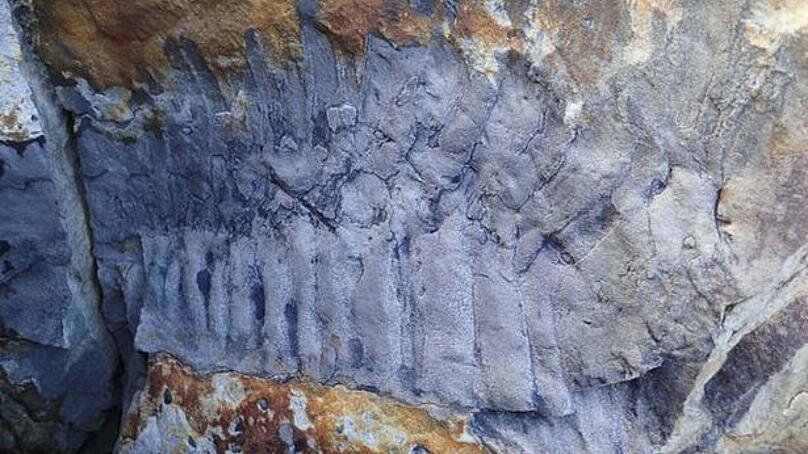One of the largest invertebrates to have ever lived once roamed the beaches of ancient England.
The giant fossil, called Arthropleura, is the largest-known invertebrate animal of all time, even bigger than the ancient sea scorpions that previously held the record.
The largest-ever land-dwelling arthropod has been discovered on a beach in northern England after a chance find by a researcher.
The giant millipede Arthropleura would have been one of the largest invertebrates ever, living over 300 million years ago. A fossilised fragment of the huge creature found in Northumberland has enabled scientists to estimate its length at around 2.6 metres, similar to that of a small car.

The Arthropleura fossil at on a beach in Northumberland.
Neil Davies
“It was a complete fluke of a discovery,” says Dr Neil Davies from Cambridge’s Department of Earth Sciences and the paper’s lead author.
“The way the boulder had fallen, it had cracked open and perfectly exposed the fossil, which one of our former PhD students happened to spot when walking by.”
Unlike the cool and wet weather associated with the region today, Northumberland had a more tropical climate in the Carboniferous Period, when Great Britain lay near the Equator. Invertebrates and early amphibians lived off this vegetation around a series of creeks and rivers.
The fossil was extracted in May 2018 with permission from Natural England and the landowners, the Howick Estate.
“It was an incredibly exciting find, but the fossil is so large it took four of us to carry it up the cliff face,” said Davies.
It was then brought back to Cambridge so that it could be examined in detail and compared with all previous records – revealing new information about the animal’s habitat and evolution.

“Finding these giant millipede fossils is rare, because once they died, their bodies tend to disarticulate, so it’s likely that the fossil is a moulted carapace that the animal shed as it grew,” says Davies.
“We have not yet found a fossilised head, so it’s difficult to know everything about them,” he concludes.
How did the millipedes get to be so large?
Arthropleura existed during the Carboniferous Period, which lasted from around 359 to 299 million years ago. At the time, Earth was much more oxygen-rich than it is now as much of the carbon was locked up in woody plants which could not easily be broken down.
While the planet’s atmosphere today contains around 21% oxygen, the atmosphere at the time had levels of over 26%, and for periods greater than 30%.
The Carboniferous is also known to have been the time when giant arthropods dominated. Insects like Meganeura, which would have looked like bird-sized dragonflies, were among the many large bugs found across the world.
It has been suggested that the higher level of oxygen at the time allowed for the insects to grow much larger. Insects breathe using trachea, tubes which deliver oxygen directly into the tissues of the body, whereas many other animal species use blood to deliver the gas.
With this system, oxygen moves relatively slowly into the bodies of insects. This means that tissues at the centre of larger arthropods wouldn’t receive enough oxygen to survive under current conditions, but if there was more oxygen in the atmosphere during the Carboniferous, then these animals may have been able to grow larger.
This concept remains strongly debated, with other theories suggesting that insects grow large to avoid the toxic effects of oxygen at high concentrations, or that a lack of flying predators allowed for them to develop larger bodies.
In any event, most Arthropleura specimens come from the latter part of the period, leading scientists to suggest that their size was related to the large amount of oxygen in the atmosphere.
However, the most recent specimen was found in rocks dating to a time when proportions of oxygen in the atmosphere was only slightly higher than today, calling this idea into question.
Sources:
https://jgs.lyellcollection.org/content/early/2021/11/19/jgs2021-115

